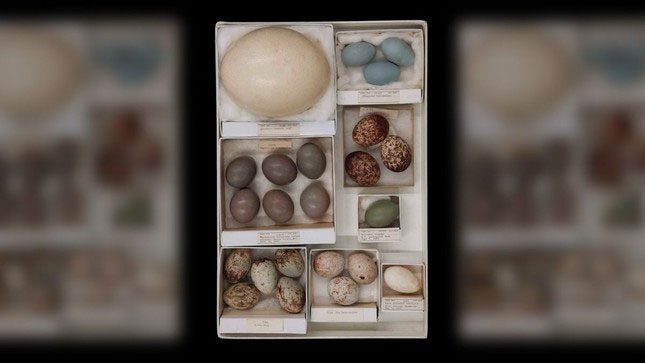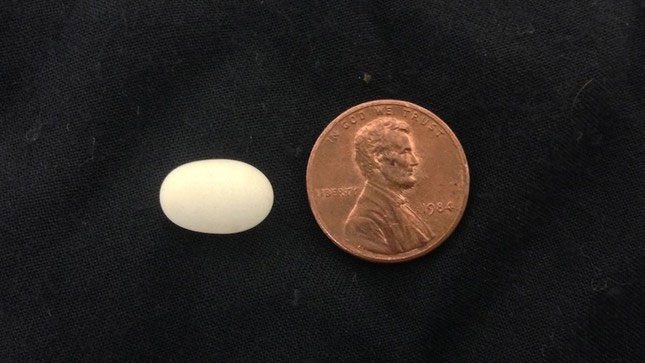Poultry eggs are symbols of rebirth and fertility, known for their diversity in shape and size.
Top 6 Interesting Facts About Bird Eggs
For instance, the kiwi’s egg makes up about 25% of the mother’s body weight, making it the largest egg relative to body size among bird species, according to researchers at the American Museum of Natural History (AMNH) in New York City. However, laying such a giant egg has its advantages: Kiwi chicks are nearly ready to fend for themselves shortly after hatching.
1. Eggs Come in Various Shapes

Eggs can be more round or more pointed, depending on the bird species.
When it comes to chicken eggs, many immediately think of a round shape, but eggs can be more round or pointed depending on the bird species.
The common murre lays a pear-shaped egg. Common murres nest on narrow cliff ledges, but the unusual shape of their eggs often keeps them safe.
Paul Sweet, the curator of ornithology collections at AMNH, states: “If you try to push one of those eggs, because it is heavier on one end, it will actually roll in a circle. That’s a way to protect it from rolling off narrow ledges.”
2. Eggs Come in Different Colors

Elephant bird eggs are twice the size of ostrich eggs.
Eggs come in various colors, including purple, green, white, and speckled. The eggshell is primarily made of calcium carbonate, which appears white to the human eye, according to the book The Book of Eggs: A Life-Size Guide to the Eggs of Six Hundred of the World’s Bird Species (University of Chicago Press, 2014).
However, some eggshells contain ultraviolet colors that are invisible to the human eye but can be perceived by birds.
Other eggshells, such as the vibrant blue of the Eurasian skylark (Alauda arvensis), display different colors. According to The Book of Eggs, two pigments are responsible for the myriad colors of eggshells: biliverdins, which produce blue-green hues, and protoporphyrins, which are responsible for rust colors like yellow, red, and brown.
According to this book, eggshells with markings, such as spots or stripes, tend to contain more protoporphyrin. These markings can help camouflage the egg. For example, the piping plover (Charadrius melodus) has speckled brown eggs that blend into the sand where the birds nest.
3. Which Bird Lays the Largest Eggs?

Thick green eggshell.
The largest known bird egg belongs to the extinct elephant bird (family Aepyornithidae). Its egg is the size of an American football, measuring about 28 cm long.
This bird itself, a giant flightless species, stood around 3 meters tall and lived in Madagascar until disease and starving sailors likely led to its extinction in the 18th century.
4. Which Bird Lays the Smallest Eggs?

The egg of a calliope hummingbird is smaller than a coin.
Sweet mentions that hummingbirds lay the smallest known bird eggs, weighing as much as a paperclip. They are slightly elongate and white.
5. Some Eggshells are Quite Thick
Most eggshells are thin enough for the chick to break through when hatching, yet thick enough to withstand the weight of the developing embryo inside and the weight of the parent bird incubating it, according to The Book of Eggs.
Some eggshells are very thick. Sweet notes that the cassowary, a flightless bird from New Guinea and northeastern Australia, lays green eggs with shells about 0.6 cm thick.
6. How Have Eggs Evolved?

Industrial chicken eggs.
According to the book on eggs, the first eggs were laid by small lizard-like animals known as “basal amniotes,” which lived about 325 million years ago during the Carboniferous period.
According to The Book of Eggs, bird eggs are “amniotic eggs,” meaning they have a hard shell and a porous membrane that allows for the exchange of oxygen and carbon dioxide. More importantly, amniotic eggs do not dry out, allowing animals to lay them on dry land.
Over time, basal amniotes diverged into two groups: synapsids (the ancestors of mammals) and sauropsids (reptiles and birds).
Birds evolved from theropod dinosaurs, a group of carnivorous dinosaurs primarily represented by Tyrannosaurus rex.


















































